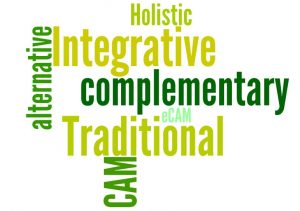About Complementary and Alternative Medicine (CAM) Therapies

'Complementary and alternative medicines are treatments that fall outside of mainstream healthcare' (NHS, 2016)
'Complementary medicine (CM) is a broad domain of healing resources that encompasses all health systems, modalities, and practices and their accompanying theories and beliefs, other than those intrinsic to the politically dominant health system of a particular society or culture in a given historical period. CM includes all such practices and ideas self-defined by their users as preventing or treating illness or promoting health and well-being. Boundaries within CM and between the CM domain and that of the dominant system are not always sharp or fixed.' (Zollman & Vickers).
Complementary therapies are those which are used alongside more traditional medicine to enhance the traditional medicine or reduce some of the side effects. Alternative medicine is used instead of traditional system, as a replacement. All the CAM therapies can be used both as complementary and alternative - it is how you use them that defines whether they are used on their own or they complement conventional medicines. Hence when describing the medicines themselves, the words 'complementary' and 'alternative' are interchangeable'.
One of the main benefits of using CAM therapies over conventional veterinary medicine is that they work with the dog’s body, helping the body to recover from injury and illness, rather than taking over and suppressing the body’s own response to a condition. Massage, acupuncture, physical therapy, magnetic therapy can all increase blood flow to tissues and muscles to aid the repair of an injury. Chiropractic treatment can realign a dog’s spine to allow the body to move more freely and the energy flows to be restored. Aromatherapy and Bach Flower Therapy can both work on the dog’s moods and emotions to restore balance, and homeopathy can be used in many ways to assist the body in ‘resetting’ itself, tackling disease and restoring proper health.
Another major benefit of using CAM therapies is that they have fewer side effects than conventional veterinary medicine. In general, CAM therapies either work or they don’t – as a generalisation they do not introduce additional problems and conditions (although it’s accepted that if not used correctly there can be unwanted effects – for example, chiropractic treatment given by an untrained person can cause issues, and dogs that are sensitive to aromatherapy oils may not respond well if the wrong oil is used).
CAM therapies do not tend to conflict with conventional veterinary medicines, so they can be used alongside most things a conventional vet may prescribe with no risk of impacting the conventional veterinary medicine. A dog given a homeopathic remedy can be treated immediately with conventional drugs, although those drugs are likely to then reduce (if not totally eliminate) the benefit of the homeopathic treatment.
Conventional veterinary medicine tends to be one of two types – either drugs to work on the chemistry within the body cells, or surgery to remove (and occasionally add) tissues, bones and foreign objects. Alternative therapies can work on the skin, the muscles, the blood flow, the immune system, chemical reactions in the body, emotions and the body as a whole.
Too often conventional veterinary medicine will treat the symptoms, not the underlying condition. Conventional vets look for the signs that the dog is suffering in some way – a limp, an itch, damaged skin, and they treat this without necessarily understanding what is causing the problem. If a dog has a fatty lump a conventional vet will often want to remove it as then the sign of the problem goes away, whereas this actually pushes the imbalance that is causing the lump further into the body. Alternative therapies are focused on finding the underlying cause and resolving this and then allowing the body to resolve itself.
Conventional veterinary medicine can also mask symptoms – for example, anti-inflammatories can remove the symptoms of the inflammation and make it appear that the cause of the inflammation has been removed, when in fact as soon as that anti-inflammatory is stopped the inflammation returns. Pain killers can make a dog believe that they are better and can run around all day, when this can instead cause more damage. Using alternative therapies are less likely to give these false messages – the dog will still be in tune with his body and improvements can be much more easily tracked.
CAM therapies are also generally cheaper than conventional veterinary medicine. Homeopathic remedies are frequently less than £10, aromatherapy oils are around this price; acupuncture sessions, chiropractic therapy, physio therapy and hydrotherapy are around the £50 mark. This compares with conventional veterinary drugs which often start around the £50 mark and surgery which is in the hundreds or thousands of pounds. However, CAM therapies frequently need more than one treatment, so this does need to be taken into account.
With CAM therapies you tend to consult with a specialist in that therapy and they will know how it impacts on the body – a chiropractor will quickly spot any misalignments with the spine, a massage therapist will notice tension in the muscles, a homeopathic vet will want to understand the whole history of the dog and treat the underlying cause rather than the symptoms. This compares with a conventional vet who is meant to be knowledgeable in all conditions, both chemical and physical, and know every drug and surgery technique available, even if they refer to a specialist once a diagnosis has been undertaken.
However, it is accepted that conventional veterinary medicine can often produce a much quicker response. Drugs can reduce inflammation, remove pain, add hormones direct into the blood supply, whilst alternative treatments need to help the body build itself back up. Surgery can remove a cancerous lump, a stick lodged in the throat, repair a broken bone, treat dental disease and results can be seen immediately, even if the body does then need time to recover and rebuild fitness.
With CAM therapies, there are also no guarantees that a particular treatment will work for a particular condition – indeed, often you need multiple treatments to solve the underlying condition.
Unlike with pharmaceutical medicines which are required to have rigorous double-blind tests before they can be licenced, CAM medicines are more steeped in history and case studies. The money is not available to undertake rigorous tests and as each treatment is tailored for that particular animal there are often no direct comparisons available. Examples of research and case studies do exist, and these can be used to demonstrate how alternative therapies can help the body to heal itself, however, not all of these case studies relate specifically to dogs.
Note (UK)
Only a vet can diagnose an animal, and only a vet can prescribe treatment for an animal.
The only forms of complementary therapy that can be given to an animal by anyone other than a vet are the manipulative therapies – however, before any of these complementary treatments are given to an animal its condition must be diagnosed by a vet and a referral / consent form completed.
Only a vet can legally give any treatment that involves intrusion into the animal’s body – this includes acupuncture. And this treatment can only be given by a vet if that vet has been specifically trained in their use.
Also, it is important to keep everyone updated if an animal is being treated under the care of more than one practitioner.
